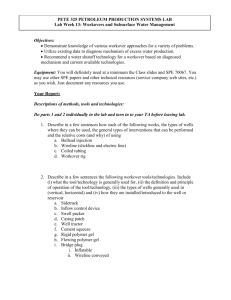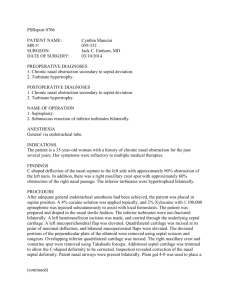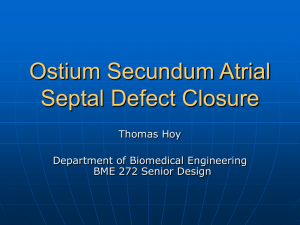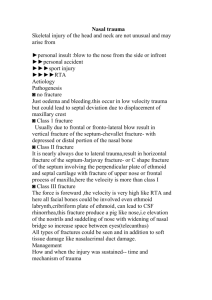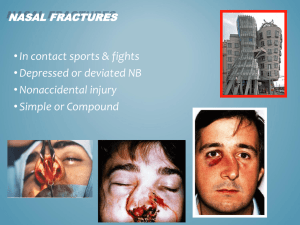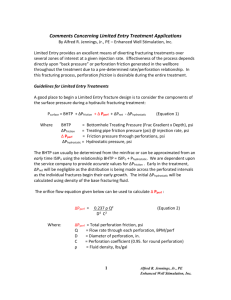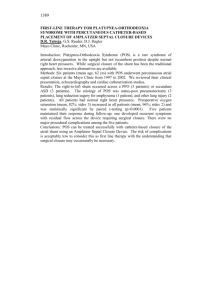Surgical treatment of nasal septal perforations. Our experience
advertisement
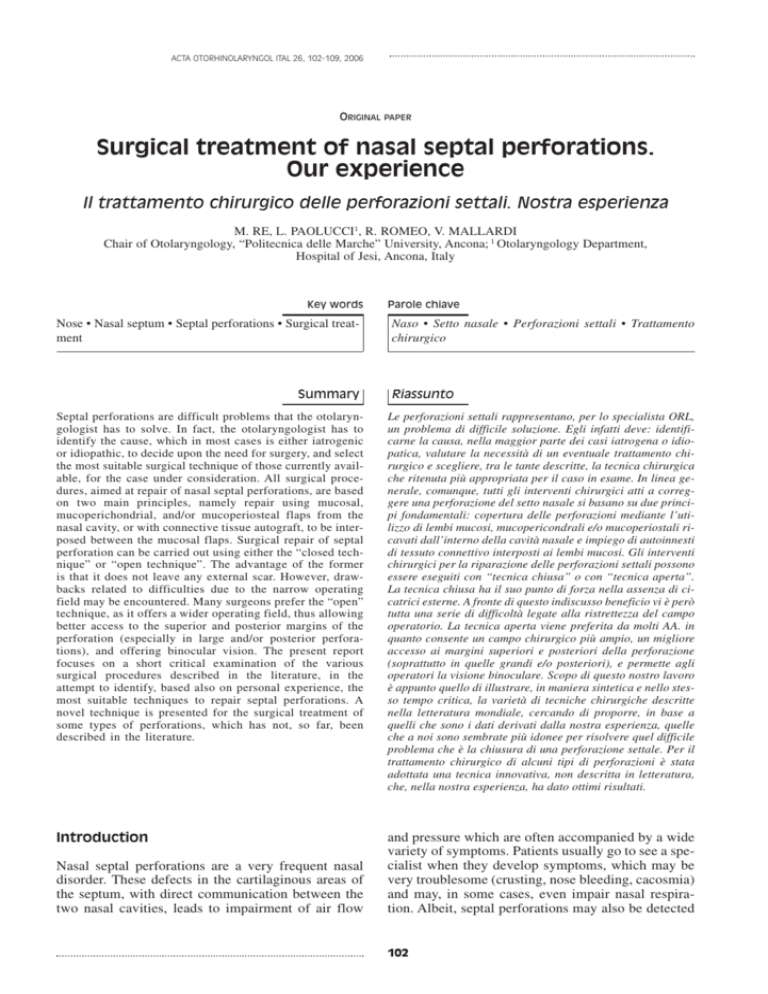
ACTA OTORHINOLARYNGOL ITAL 26, 102-109, 2006 ORIGINAL PAPER Surgical treatment of nasal septal perforations. Our experience Il trattamento chirurgico delle perforazioni settali. Nostra esperienza M. RE, L. PAOLUCCI1, R. ROMEO, V. MALLARDI Chair of Otolaryngology, “Politecnica delle Marche” University, Ancona; 1 Otolaryngology Department, Hospital of Jesi, Ancona, Italy Key words Nose • Nasal septum • Septal perforations • Surgical treatment Summary Parole chiave Naso • Setto nasale • Perforazioni settali • Trattamento chirurgico Riassunto Septal perforations are difficult problems that the otolaryngologist has to solve. In fact, the otolaryngologist has to identify the cause, which in most cases is either iatrogenic or idiopathic, to decide upon the need for surgery, and select the most suitable surgical technique of those currently available, for the case under consideration. All surgical procedures, aimed at repair of nasal septal perforations, are based on two main principles, namely repair using mucosal, mucoperichondrial, and/or mucoperiosteal flaps from the nasal cavity, or with connective tissue autograft, to be interposed between the mucosal flaps. Surgical repair of septal perforation can be carried out using either the “closed technique” or “open technique”. The advantage of the former is that it does not leave any external scar. However, drawbacks related to difficulties due to the narrow operating field may be encountered. Many surgeons prefer the “open” technique, as it offers a wider operating field, thus allowing better access to the superior and posterior margins of the perforation (especially in large and/or posterior perforations), and offering binocular vision. The present report focuses on a short critical examination of the various surgical procedures described in the literature, in the attempt to identify, based also on personal experience, the most suitable techniques to repair septal perforations. A novel technique is presented for the surgical treatment of some types of perforations, which has not, so far, been described in the literature. Le perforazioni settali rappresentano, per lo specialista ORL, un problema di difficile soluzione. Egli infatti deve: identificarne la causa, nella maggior parte dei casi iatrogena o idiopatica, valutare la necessità di un eventuale trattamento chirurgico e scegliere, tra le tante descritte, la tecnica chirurgica che ritenuta più appropriata per il caso in esame. In linea generale, comunque, tutti gli interventi chirurgici atti a correggere una perforazione del setto nasale si basano su due principi fondamentali: copertura delle perforazioni mediante l’utilizzo di lembi mucosi, mucopericondrali e/o mucoperiostali ricavati dall’interno della cavità nasale e impiego di autoinnesti di tessuto connettivo interposti ai lembi mucosi. Gli interventi chirurgici per la riparazione delle perforazioni settali possono essere eseguiti con “tecnica chiusa” o con “tecnica aperta”. La tecnica chiusa ha il suo punto di forza nella assenza di cicatrici esterne. A fronte di questo indiscusso beneficio vi è però tutta una serie di difficoltà legate alla ristrettezza del campo operatorio. La tecnica aperta viene preferita da molti AA. in quanto consente un campo chirurgico più ampio, un migliore accesso ai margini superiori e posteriori della perforazione (soprattutto in quelle grandi e/o posteriori), e permette agli operatori la visione binoculare. Scopo di questo nostro lavoro è appunto quello di illustrare, in maniera sintetica e nello stesso tempo critica, la varietà di tecniche chirurgiche descritte nella letteratura mondiale, cercando di proporre, in base a quelli che sono i dati derivati dalla nostra esperienza, quelle che a noi sono sembrate più idonee per risolvere quel difficile problema che è la chiusura di una perforazione settale. Per il trattamento chirurgico di alcuni tipi di perforazioni è stata adottata una tecnica innovativa, non descritta in letteratura, che, nella nostra esperienza, ha dato ottimi risultati. Introduction and pressure which are often accompanied by a wide variety of symptoms. Patients usually go to see a specialist when they develop symptoms, which may be very troublesome (crusting, nose bleeding, cacosmia) and may, in some cases, even impair nasal respiration. Albeit, septal perforations may also be detected Nasal septal perforations are a very frequent nasal disorder. These defects in the cartilaginous areas of the septum, with direct communication between the two nasal cavities, leads to impairment of air flow 102 SURGICAL TREATMENT OF NASAL SEPTAL PERFORATIONS during routine medical examinations. Anterior and wide septal perforations are more symptomatic, while posterior perforations tend to be less symptomatic, due to humidification from the turbinates. Small perforations refer to those with a diameter of ≤ 0.5 cm; medium perforations with a diameter ranging between 0.5-2 cm; large perforations with a diameter > 2 cm 1-3. Septal perforations are difficult problems for the otolaryngologist to solve. The otolaryngologist has to: identify the causes, which, in most cases, are iatrogenic or idiopathic 1-4; decide upon the need for surgical treatment, and select the technique most suitable, among those currently available, for the case under consideration. Surgery is indicated in the presence of symptomatic perforations while surgical repair is not usually recommended for perforations not presenting subjective and functional disorders. Contraindications for surgery include: pathological conditions for which general anaesthesia would represent a severe risk factor; chronic nasal inflammatory processes (including Sarcoidosis, Wegener Granulomatosis, etc.), and continuous use of cocaine 5. Surgery aimed at correcting nasal septal perforations is based on two main principles: repairing the perforation using mucosal mucoperichondrial and/or mucoperiosteal flaps from the internal nasal cavity, and connective tissue autografts interposed between the mucosal flaps. In the early fifties, some Authors proposed the use of prosthetic devices. Although these devices have been improved over time, as far as concerns the materials used they are invariably ill tolerated as they are perceived as foreign bodies 6. However, silicone prosthetic devices can be used in those patients presenting contra-indications for surgery. Septal perforation repair surgery can be performed using either the “closed technique” or “open technique” 1-4. The advantages of the former consist in the fact that it does not leave any external scar. Albeit, many Surgeons prefer the “open” technique, as it offers a wider operating field, thus allowing better access to the superior and posterior margins of the perforation (especially in large and/or posterior perforations), and affording binocular vision 6-11. Following a review of the various surgical techniques described in the literature, the present report aims to briefly and critically analyse these data in the attempt to identify, based on personal experience, the most suitable techniques available to repair septal perforations. An innovating technique, adopted for the surgical treatment of some types of perforations, is also described herein which has not, so far, been described in the literature, but which, in our experience, has given good results. 103 Use of the “closed technique” to correct nasal sectal perforations In 1947, Seifert proposed the use of sliding flaps obtained through a crescent-shaped incision, 1 cm from the perforation margin 12. In 1947, Seiffert again described both the use of a rotation flap incised on the inferior turbinate, and a technique involving the creation of a synechia between the perforation site and the inferior or middle turbinate 12. In 1964, Meyer proposed, for caudal perforations, to use sliding flaps from the nasal fossae floor 13. The technique suggested by Gollom in 1968, involves a posterior local mucosal advancement flap with a posteriorly positioned pedicle, called “reverse flap” which, on one side of the septum shows a posterior-hinge flap, and, on the other, an anterior-hinge flap 14. In 1972, Meyer described a procedure envisaging the use of a mucocartilaginous flap, containing medial pedicle triangular cartilage, rotating on the loss of substance and, the same year, proposed a technique to repair large perforations by a composite flap, created in the oral vestibule 13. In 1977, Converse et al., described a technique consisting in creating a large rectangular mucous membrane flap near the oral vestibule, the basis of which is located on the fraenum, which is rotated, in the nose, through a perforation made in the floor of the vestibule. The distal edge of the flap is positioned on the perforation and, then, sutured; the raw surface, corresponding to the perforation contralateral ostium, is lined with an oral mucous membrane flap 15. In 1980, Fairbanks adopted a closed approach performing a vertical incision in the mucosa and oneside perichondrium, near the lower margin of the quadrangular cartilage, a few millimetres from the space between the mucosa and vestibule cutis. The fibro-mucosal plane is then separated on both sides, and the pockets are prepared for the introduction of an intramucous support, consisting of temporal fascia or cranial periosteum (pericranium). The operating field is then covered, by sliding the surrounding septal mucosa, which is sutured on both sides. Fairbanks reported a 95% success rate 16 17. In 1982, Karlan described a sub-labial approach, with a pedicled mucosal flap on the labial artery 18. In 1997, Yousef-Mian using a rotation mucosal flap, supplied by sphenopalatine artery branches, obtained excellent results on 14 patients with septal perforations < 3 cm (93% complete perforation closure, 7% partial closure) 19. In 1999, Sarandeses-Garcia et al. described the “backwards extraction-reposition technique of the quadrangular cartilage”, performed on 30 patients M. RE ET AL. with small anterior septal perforations, and obtained, after min. 2-year follow-up, 87% success rate 20. In 2003, Ayshford et al., used endoscopy for small and medium-sized nasal perforations, cutting a rotation flap in the inferior turbinate, and using a cellular human dermal allograft (Alloderm, Life-Cell Corporation, Branchburg, NJ, USA) as interposition graft. They obtained complete closure in 13 out of 17 patients (76%) 21. In 2003, Friedman proposed, again, for small and medium caudal perforations (< 2 cm diameter), a rotation flap cut in the inferior turbinate, reporting a 92% success rate 22. In 2004, Stoor and Grenman, in 24 patients with septal perforations (< 2 cm diameter), used bioactive glass (Bioactive Glass – S53P4) as graft material, interposed between the rotated flaps of the inferior turbinate, obtaining full repair of the perforation in 96% of cases 23. Use of the “open technique” to correct septal perforations In 1978, Strelzow and Goodman first described the open technique approach and, in 1982, for extensive vertical axis perforations, they proposed using two superior and inferior-hinge bipedicled flaps, with an anterior and a posterior freeing incision; conversely, when confronted with extensive horizontal axis perforations, two anterior and posterior-hinge bipedicled flaps were utilised, together with a superior and an inferior freeing incisions 7 8. In 1986, Kridel used a posterior-hinge monopedicled mucoperichondrial advancement flap, obtained from the nasal floor and inferior meatus; moreover, he was the first to describe, in 12 cases, the introduction of mastoidal periosteum as interposition material, reporting a 77% success rate 9. In 1988, Romo and Foster proposed midface degloving and the use of monopedicled posterior bilateral flaps, in 24 patients with large septal perforations (> 3 cm), who had already undergone unsuccessful surgical repair; they reported perforation closure in 77% of the cases 24. In 1989, Kuriloff described a modification of the open technique approach, aiming at further increasing exposure 25. In 1989, Eviatar and Myssiorek proposed the use of tragal cartilage, together with the entire perichondrium, as graft material 26. In 1992, Hussain and Kay described the creation of a “sandwich” consisting of a tragal cartilage middle layer, and mucoperichondrial membranes from the two lateral inferior turbinates 27. In 1995, Romo et al. described the use of specific ex- panders for the nasal mucosa, in 5 patients presenting large septal perforations (diameter > 4 cm), reporting, after minimum 1-year follow-up, full closure of nasal perforations, in all cases 28. In 1998, La Rosa et al. presented a personal modification to Fairbanks’ technique, involving use of the open approach and closing of the flaps on one side only; he reported a success rate of 80% for small septal perforations, and 83.3% for medium-sized perforations 29. In 1998, Kridel et al. used, as graft material between the nasal mucosa bipedicled sliding flaps, an acellular human dermal allograft (Alloderm, Life-Cell Corporation, Branchburg, NJ, USA), in 12 patients presenting septal perforations with diameters < 3 cm, and reported full closure of the perforations in 11 out of 12 (success rate 92%) 30. In 1999, Lee et al. described the use of a dermal autograft, as interposition material, in 14 patients presenting small and medium-sized septal perforations, reporting full closure in 64% of cases, and partial closure in 16% 31. In 1999, Romo proposed multiple stage procedures to repair large septal perforations, showing success rates ranging between 45% and 90% 32. In 2000, Paloma et al. successfully adopted the open approach with a pericranial rotation flap, to repair a large anterior septal perforation 33. In 2001, Mobley et al. described repairing a large septal perforation (> 4 cm) with “radial free flap” anastomised to the facial artery and vein 34. In 2003, Bryan et al., after adopting the open technique and bipedicled sliding flaps, used as interposition graft, porcine small intestinal submucosa (Surgi Sis, Cook Biotech Inc, West Lafayette, Ind., USA), on 10 patients with septal perforations ranging between 0.4 cm and 2 cm, obtaining excellent results, with full closure being reported in all cases 35. Material and methods In the present investigation, a retrospective assessment was performed of 31 cases of nasal septal perforation, in which surgical repair had been performed at the Jesi (AN) Hospital Otolaryngology Department between January 1996 and December 2002. Of these 31 patients, 19 were male (61.3%) and 12 female. Median age was 36.1 years with 8 patients (25.8%) in the 20-30 age bracket, 19 (61.3%) in the 31-40 age group, and 4 (12.9%) > 40 years (Table I). A detailed description of the aetiology of the nasal septal perforations is reported in Table II. Depending on the initial size, perforations were classified as follows: 10 small perforations, 15 mediumsized perforations and 6 large perforations (Table III). 104 SURGICAL TREATMENT OF NASAL SEPTAL PERFORATIONS Table I. Patients classified according to age group. Table III. Septal perforation classification according to size. Age group (yrs) Size No. patients (%) (%) No. patients (%) 20-30 31-40 > 40 8 (25.8) 19 (61.3) 4 (12.9) Small (< 0.5 cm) Medium (> 0.5-2 cm) Large (2 cm) 10 (32.2) 15 (48.4) 6 (19.4) Total 31 (100) Total 31 (100) Table II. Septal perforations classified according to aetiology. Causes No. patients (%) Previous septal surgery 9 (29.1) Nasal traumas 7 (22.7) Cautery 5 (16.2) Nasal sprays 4 (12.9) Chromic acid fumes 2 (6.4) Atrophic rhinitis 1 (3.2) Cocaine abuse 1 (3.2) Unknown causes 2 (6.4) Total Table IV. Septal perforation symptoms. Symptoms No. patients (%) Crusting rhinitis Epistaxis Whistle Nasal obstruction Pain Headache Voice changes No symptoms 29 (93.6) 10 (32.2) 10 (32.2) 9 (29.1) 4 (12.9) 3 (9.7) 3 (9.7) 2 (6.4) Total 31 (100) 31 (100) All patients treated were symptomatic, except for 2 presenting small perforations (Table IV). Personal experience As far as concerns the technique used, personal experience consisted, essentially, in performing the Cottle technique, with subperichondrial and subperiosteal dissections, aimed at creating the four typical tunnels. This approach, besides achieving optimal exposure of the septum, also allowing assessment of the missing areas and transposing some of its parts, the essential precondition is met for the creation of mucoperichondrial and mucoperiosteal sliding flaps, especially if the inferior tunnel dissection is pro- longed down to the lower insertion margin of the inferior turbinate. On the other hand, the feasibility of using the closed or open technique may be discussed. We employed the closed technique (Table V) for small and medium-sized perforations: indeed, the dissections and tunnels obtained using Cottle technique are sufficient to create the space required both for mucoperichondrial grafts and sliding. Likewise, for anterior perforations which, in fact, are usually more symptomatic and lead patients to see a specialist. The open technique, combined with dissections and tunnels created by implementing the Cottle technique, should undoubtedly be preferred when large perforations are involved, especially if they are located in a posterior site (Table V). We preferred this technique on account of the advan- Table V. Cases classified according to techniques used. No. patients (%) Techniques Open technique, using various grafts Closed technique, with mucoperichondrial sliding and/or using various grafts 105 7 (22.6) 24 (77.4) M. RE ET AL. tages it offers: better access to superior posterior margins of the perforation; better exposure of the perforation, with no distortions caused by retraction manoeuvres; binocular vision for surgeons and assistants, and two free hands. This is obtained at the cost of a small and almost invisible reversed V-shaped cutaneous columellar incision, and a possible slight rotation of the nasal tip, due to the dissection between the alar cartilage medial crura and septum. Should rotation occur and be excessive, it should be corrected. Finally, as far as concerns the material used to repair perforations, heterologous materials showed poor long-term results, thus confirming, once again, that these substances are not well tolerated by the nose. Although we agree that homologous materials may be used, we believe, like other Authors 5 8 9 16 that autologous grafts are to be preferred. The only exception we would accept consists in the use of bovine cartilage, failing suitable bony or cartilaginous support structures from the patient’s bony or cartilaginous septum, which may possibly be transposed to the perforation site. Indeed, treated bovine cartilage without perichondrium only plays an inert support function with respect to the graft, and has negligible antigenic power. For anterior cartilaginous perforations, we used the temporalis fascia, obtaining excellent results while for small and medium-sized perforations, good results were achieved using the Eviatar technique, involving taking some tragal cartilage together with perichondrium bilaterally. The main advantage of this technique is that it represents, in itself, a composite graft, already with a support. Especially for large perforations, we very recently started using mucosa attached to small cavernous tissue fragments only, taken bilaterally from the inferior turbinate, performing the “inferior turbinate decortication” technique. The raw surface of the two turbinate fragments are then corrected with catgut suture, interposing in te middle small cartilagenous sheets. Even if used in only a very few cases, this method was very satisfactory from a surgical viewpoint. A few technical aspects need to be adhered to in order to guarantee a successful surgical outcome, namely: – The graft material, regardless of its nature (fascia temporalis, mastoid or cranial periosteum, etc.), should not show any sign of a fold. If it does, which is likely to occur, it may lead to a new perforation. In this respect, a good method consists in allowing the material to “dry”. – The diameter of the grafted material must exceed that of the perforation, and all margins must be covered with nasal mucosa surrounding the perforation, by at least 1 cm without tension. This is in order to avoid new perforations in the post-operative period, due to contraction caused by the scar-tissue healing. – It is good practice to cover the graft by part of the nasal mucous membrane, by creating sliding flaps and suturing them together. It is important that the sliding of the mucosa takes place asymmetrically in the two nasal fossae, in order that the septal cartilage is uncovered in non-corresponding areas in the two nasal fossae: in fact, symmetrical sliding would entail new septal perforation, maybe in a different site. Fixing the graft onto the mucosa, in the selected point, may be much easier using biological glue (Tissucol, BaxterInt. Inc., United States). The juxtaposition, at the end of surgery, within each nasal fossa, of a silastic sheet is extremely important for successful surgery. These sheets must be maintained for a prolonged period of time, i.e., 3-5 weeks. A soft nasal swab (Lyofoam, Convatel, UK), to be kept in situ for 3 days, usually completes the surgical procedure. We performed a post-operative endoscopic follow-up every 3 months for the first year, and, thereafter, examinations every 6 months. Overall, patients were followed up for a minimum of 2.2 years to a maximum of 7.2 years (mean 2.9 years). Results SMALL PERFORATIONS Closure of the perforation was obtained in all cases. More specifically: 6 patients were treated by performing asymmetric mucoperichondrial sliding of the mucosa of the two nasal fossae, after making a Cottle tunnel, adopting the closed technique. The perforation margins were sutured with thin stitches. The problem concerning lack of cartilage was solved by sliding the vomer, residual cartilage or the perpendicular lamina forward to the ethmoid, depending on the individual case. Four patients were treated by grafting tragal cartilage within the perichondrium, between the nasal fossae sliding mucoperichondrial flaps. MEDIUM-SIZED PERFORATIONS Five patients were treated by grafting some dried fascia temporalis (as in myringoplasty surgery). The graft was supported by transposition of the nasal septum. Asymmetric mucoperichondral sliding of the mucosa of the nasal fossae was performed in all cases. Fixation was obtained using Tissucol. All surgical treatments were successful. Four patients were treated by using fascia temporalis, supported by bovine cartilage grafts (AudioTechnologies srl, Grossolengo, Piacenza, Italy). 106 SURGICAL TREATMENT OF NASAL SEPTAL PERFORATIONS Asymmetric mucoperichondrial sliding was performed. Fixation was obtained using Tissucol, as in the above-mentioned cases. All surgical treatments were successful. Six patients were treated using Eviatar: i.e., tragal cartilage grafting. In 2 cases, monoblock cartilage was not sufficient. Hence, the perichondrium was separated on one side, in order to increase its size. One (female) of these two patients presented a new perforation one year later, although the previous one appeared closed when examined at follow-up, 3 and 6 months after surgery. In fact, the patient’s first perforation had no apparent cause; it had occurred spontaneously and was supposedly due to atrophy. LARGE PERFORATIONS Two patients were treated by performing combined grafts of bovine peritoneum and bovine cartilage (Audio-Technologies srl, Grossolengo, Piacenza, Italy). The first patient immediately showed a new perforation and graft expulsion; a new perforation was observed in the other patient after 2 months. Another four patients were treated with turbinal mucosa (and nearby small cavernous tissue fragments), and bovine cartilage combined graft, sutured by thin catgut stitches. One patient showed subtotal closure, with almost 1/4 anterior inferior residual perforation compared to its original size (was the graft too small or incorrectly positioned?). Three patients showed complete closure of the perforations. All large perforations were treated adopting the open technique. The results obtained are outlined in Tables VI-IX. Conclusions As can be seen from the experience described, septal perforations, and large ones in particular, are difficult problems to solve. Table VI. Results classified according to age group. Age group (yrs) 20-30 31-40 > 40 Complete closure (%) Subtotal closure (%) Failure (%) 8 (100) 16 (84.2) 3 (75) 0 1 (5.3) 0 0 2 (10.5) 1 (25) Complete closure (%) Subtotal closure (%) Failure (%) 10 (100) 14 (93.3) 3 (50) 0 0 1 (16) 0 1 (6.7) 2 (33.3) Complete closure (%) Subtotal closure (%) Failure (%) 8 (89.9) 2 (100) 7 (100) 5 (100) 1 (100) 2 (50) 1 (100) 1 (50) 0 0 0 0 0 0 0 1 (50) 1 (10.1) 0 0 0 0 2 (50) 0 0 Table VII. Results classified according to original perforation size. Size Small (< 0.5 cm) Medium (0.5-2 cm) Large (> 2 cm) Table VIII. Results classified according to aetiology. Aetiology Former septal surgery Nasal traumas Cautery Nasal sprays Chromic acid fumes Atrophic rhinitis Cocaine abuse Unknown causes 107 M. RE ET AL. Table IX. Results classified according to surgical technique used. Technique No. patients Asymmetric mucoperichondrial sliding Tragal cartilage graft Fascia temporalis graft, with asymmetric mucoperichondrial sliding Fascia temporalis and bovine cartilage combined graft with asymmetric mucoperichondrial sliding Bovine peritoneum and bovine cartilage combined graft Turbinal mucosa and bovine cartilage combined graft The surgical techniques offering the highest perforation closure rates, the best physiological results and which are more acceptable to patients, involve an open approach, using advancement mucosal flaps, with a connective tissue interposition graft 5 9. This technique allows closure of > 90% of perforations with a diameter < 3 cm 5 9; this figure is confirmed by one of the largest case studies in the literature, in which a 95.2% success rate is reported in 126 patients 36. Immediate and short-term results are always better compared to those observed at 1- or 2-year followup. Indeed, initial enthusiasm, which may seem justified by the clinical anatomical results obtained immediately after surgery (1-3 months), is chilled when relapse of perforations occurs 1-2 years post-operatively. Furthermore, perforations are more likely to relapse in an atrophic environment: in fact, in our experience, small iatrogenic perforations, for instance, almost always closed without relapsing. As far as concerns perforation size, regardless of the case, technique and material used, small and medium perforations are generally treated successfully. Large perforations, especially if involving the nasal septum subtotally or extensively in the vertical axis, are more difficult to repair (maximum closing ten- 2 3 4 La Rosa R, Fibbi A, Staffieri A. Chirurgia delle perforazioni settali. In: La Rosa R, Fibbi A, Staffieri A, editors. Chirurgia funzionale ed estetica del naso. Bologna: Planning Congressi Ed.; 1999. p. 395-412. Romo T, Toffel PH. Nasal septal perforation. In: Gates GA, editor. Current therapy in Otolaryngology Head and Neck Surgery. St. Louis: Mosby; 1998. p. 339-44. Younger R, Blookmanis A. Nasal septal perforations. J Otolaryngol 1985;14:126-31. Teichgraeber JF, Russo RC. The management of septal per- Subtotal closure (%) Failure (%) 6 10 5 6 (100) 9 (90) 5 (100) 0 1 (10) 0 0 0 0 4 2 4 4 (100) 0 3 (75) 0 0 0 0 2 (100) 1 (25) sion spans from the nose floor to the dorsum) 5; usually the outcome is only partially successful and further surgery is necessary 32. In clinical practice, this rarely occurs, inasmuch as patients are unlikely to be willing to undergo multiple operations, especially if the initial operation has eliminated the worst symptoms, such as nasal stenosis and/or relapsing epistaxis. Our experience confirmed that the rationale for nasal perforation repair surgery is the creation of the four Cottle tunnels, either with the closed or open techniques (the latter is undoubtedly the better option to treat large perforations). One should prefer grafts with autologous material, and this graft should be covered, as much as possible, with asymmetric mucoperichondrial sliding flaps created in the two nasal fossae. Symptomatic perforations (crusting rhinitis, epistaxis, etc.) are doubtless to be surgically treated. Surgery should always be preceded by a careful analysis of the perforation size, especially in terms of height: in fact, perforations should always be considered larger than they actually are. This allows more accurate selection of the graft required, thus excluding possible impromptu and empirical solutions which could jeopardise surgical outcome. forations. Plast Reconstr Surg 1993;91:229-35. References 1 Complete closure (%) 5 Kridel RW. Septal perforation repair. Otolaryngologic Clin N Am 1999;32:695-724. 6 Facer GW, Kern EB. Non surgical closure of nasal septal perforations. Arch Otolaryngol Head Neck Surg 1979;105:6-8. 7 Strelzow VV, Goodman WS. Nasoseptal perforations closure by external rhinoplasty. J Otolaryngol 1978;7:43-8. 8 Goodman WS, Strelzow VV. The surgical closure of nasoseptal perforations. Laryngoscope 1982;92:121-4. 9 Kridel RW, Appling WD, Wright WK. Septal perforation 108 SURGICAL TREATMENT OF NASAL SEPTAL PERFORATIONS 10 11 12 13 14 15 16 17 18 19 20 21 22 23 closure utilizing the external septorhinoplasty approach. Arch Otolaryngol Head Neck Surg 1986;112:168-72. Arnstein DP, Berke GS. Surgical considerations in the open rhinoplastic approach to closure of septal perforations. Arch Otolaryngol Head Neck Surg 1989;115:435-8. Raman R. Closure of large septal perforations. Laryngoscope 1990;100:789-90. Seiffert W. Plastic surgery of the head and neck. New York: Springer-Verlag 1964;140. Meyer R. Repair techniques in perforations of the nasal septum. Ann Plast Surg Esthet 1992;37:154-61. Gollom J. Perforations of the nasal septum. Arch Otolaryngol Head Neck Surg 1968;88:518-22. Converse JM. Corrective rhinoplasty. In: Converse JM, editor. Reconstructive plastic surgery. Toronto: WB Saunders Co; 1977. p. 1150-2. Fairbanks DNF. Closure of nasalseptal perforations. Arch Otolaryngol Head Neck Surg 1980;106:509-13. Fairbanks DNF, Fairbanks GR. Nasal septal perforations: prevention and management. Ann Plasr Surg 1980;5:452-9. Karlan MS, Ossoz R, Sisson GA. A compendium of intranasal flaps. Laryngoscope 1982;92:121-4. Yousef-Mian M. Repair of nasal septal perforation. Am J Rhinol 1997;11:35-40. Sarandeses-Garcia A, Sulsenti G, Lopez-Amado M, Martinez-Vidal J. Septal perforation closure utilizing the backwards extraction-reposition technique of the quadrangular cartilage. J Laryngol Otol 1999;113:721-4. Ayshford CA, Shykhon M, Uppal HS, Wake M. Endoscopic repair of nasal septal perforation with a cellular human dermal allograft and an inferior turbinate flap. Clin Otolaryngol Allied Sci 2003;28:29-33. Friedman M, Ibrahim H, Ramakrishnan V. Inferior turbinate flap for repair of nasal septal perforation. Laryngoscope 2003;113:1425-8. Stoor P, Grenman R. Bioactive glass and turbinate flaps in the repair of nasal septal perforations. Ann Otol Rhinol Laryngol 2004;113:655-61. ■ Received: April 3, 2005 Accepted: November 11, 2005 ■ Address for correspondence: Dr. M. Re, Istituto di Scienze Odontostomatologiche, Cattedra di Otorinolaringoiatria, Università Politecnica delle Marche, via Tronto, 60020 Torrette di Ancona, Italy. Fax: +39 071 2206221. E-mail: remassimo@hotmail.com 109 24 25 26 27 28 29 30 31 32 33 34 35 36 Romo TR, Foster CA. Repair of nasal septal perforation utilizing the midface degloving technique. Arch Otolaryngol Head Neck Surg 1988;114:739-42. Kuriloff DB. Nasal septal perforations and nasal obstructions. Otolaryngol Clin North Am 1989;22:333-50. Eviatar A, Myssiorek D. Repair of nasal septal perforation with tragal cartilage and perichondrium grafts. Otolaryngol Head Neck Surg 1989;100:300-2. Hussain A, Kay N. Tragal cartilage inferior turbinate mucoperiosteal sandwich graft technique for repair of nasal septal perforations. Arch Otolaryngol Head Neck Surg 1992;106:893-5. Romo T, Jablonski RD, Shapiro AL, McCormick SA. Longterm nasal mucosal tissue expansion use in repair of large nasoseptal perforations. Arch Otolaryngol Head Neck Surg 1995;121:327-31. La Rosa R, Medina L, Gallotto P. Le perforazioni del setto nasale: considerazioni chirurgiche. Acta Otorhinolaryngol Ital 1998;18:288-92. Kridel RWH, Foda H, Lunde KC. Septal perforation repair with acellular human dermal allograft. Arch Otolaryngol Head Neck Surg 1998;124:73-8. Lee D, Joseph EM, Pontell J, Turk JB. Long-term results of dermal grafting for the repair of nasal septal perforations. Otolaryngol Head Neck Surg 1999;120:483-6. Romo T. A graduated approach to the repair of nasal septal perforations. Plast Reconstr Surg 1999;103:66-75. Paloma V, Samper A, Cernera-Paz FJ. Surgical technique for the reconstruction of the nasal septum: the pericranial flap. Head Neck 2000;22:90-4. Mobley SR, Boyd JB, Astor FC. Repair of a large septal perforation with a radial forearm free flap: brief report of a case. Ear Nose Throat J 2001;80:512. Bryan TA, Zimmerman J, Rosenthal M, Pribitkin EA. Nasal septal repair with porcine small intestinal submucosa. Arch Facial Plast Surg 2003;5:528-9. Schultz-Coulon HJ. Nasal septum repair-plasty with pedicle flap technique in 126 patients. An analysis. Laryngorhinootologie 1997;76:466-74. M. RE ET AL. 110
